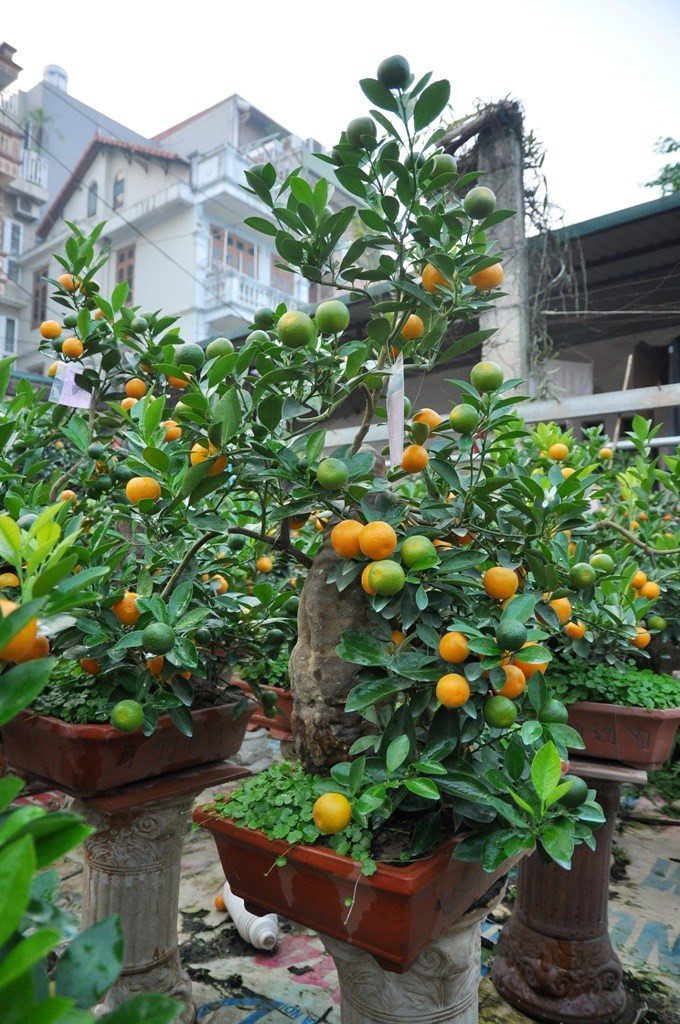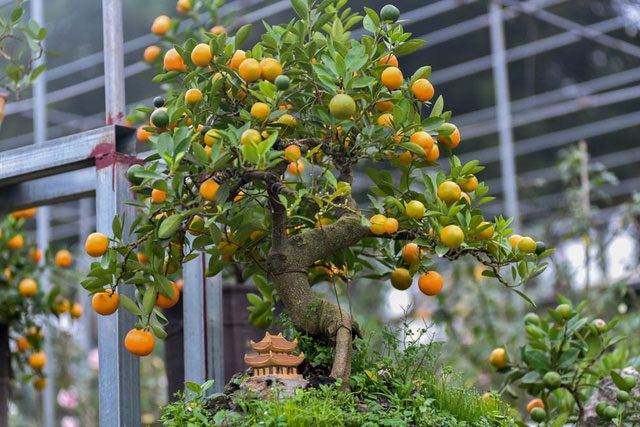Since ancient times, Vietnamese people have considered the kumquat tree as a symbol representing peace, luck, and family harmony.
What could be more wonderful than decorating your home for Tet with a pot of ripe, vibrant kumquats? During the period from just before Tet until January and February, people often display kumquats in their homes.
As you may know, kumquats are not only used as a flavoring ingredient in noodle dishes but are also grown as ornamental plants to beautify living spaces. Every year during Tet, families shop for peach and kumquat trees, which are both delicious and beautiful. Are you interested in learning how to grow kumquats in pots so you can enjoy them at home?
Choosing a Pot for Kumquat Trees
To grow kumquats in pots, you need a bit of skill and understanding of the plant. From the very beginning, it’s essential to choose the right variety of tree. You can either purchase a pre-germinated kumquat tree or grow one from seeds, which will take longer.
Pots made of clay or ceramic are commonly used for kumquats.
First, you need to select a pot that suits your tree. The pot should be of moderate width—not too wide or too narrow. It’s advisable to buy a pot that is about 25% larger than the root ball of the tree you plan to plant. Clay pots are the most optimal choice since they allow for better moisture evaporation compared to plastic pots, preventing the plant from becoming waterlogged.

It is recommended to change pots every 2 years to accommodate the tree’s growing size.
Using kumquat seeds for planting is also possible but will take longer to bear fruit. Therefore, it’s best to buy a ready-to-sell tree from markets or nurseries that sell ornamental kumquat trees.
During the growing process, you should replace the pot every 2 years to match the tree’s growth. Typically, each time you repot, choose a pot that is larger than the old one, and it’s best to repot during winter.
Choosing Soil for Kumquat Trees
Kumquats are usually grown in garden soil mixed with sand and clay to ensure good aeration and moisture retention. The ideal pH level is between 5-6.
Quality soil is one of the top factors to consider when planting kumquats. Kumquat trees can grow in various soil types, but the best option is loose, rich loamy soil with plenty of organic matter. When preparing the planting hole, add 1-2 kg of organic fertilizer or 3-5 kg of decomposed manure as a base fertilizer.
Caring for Kumquat Trees
Caring for kumquat trees cannot overlook the importance of fertilizing the plants about once a month during the growing season. If kumquat trees are fertilized regularly and with the right amount, they will produce larger, juicier, and more beautiful fruit compared to those that are not properly cared for.
In addition to the initial fertilization, once the kumquats start to flower, it’s important to apply additional potassium fertilizer to encourage quicker fruit set.
When watering kumquat trees after planting, be careful with the amount of water to avoid over-saturation, which can cause root rot. If the soil becomes too dry, salts may accumulate and harm the roots. Therefore, it’s crucial to keep the soil consistently moist.
Finally, kumquat trees are not only used for their fruit but also to beautify your home. Thus, you should regularly prune the branches and leaves to shape the tree according to your personal style.

Kumquat trees that are fertilized regularly will yield larger and more beautiful fruit.
Pruning and Shaping
Each year, prune the tree 3-4 times to encourage even growth and a cone-shaped canopy.
Be sure to regularly apply pest control treatments after pruning to prevent pests, especially leaf-mining caterpillars.
Timing for Fruit Ripening for Tet
Kumquats bear fruit year-round, so adjustments must be made to ensure that the fruit ripens right before Tet. Here’s how:
Around the 6th or 7th lunar month, begin regularly checking your kumquat trees.
- Identify any trees with vigorous fruit development and dig them up.
- Expose them to sunlight for about 10 days.
- Then, trim away excess branches and leaves to keep the tree tidy and replant it (transplant the kumquat).
If growing in baskets or pots, simply remove all the fruit and minimize watering.
By mid to late August of the lunar calendar, prepare the tree for flowering and fruiting so that the fruits turn golden by Tet. During this period, ensure the kumquat tree is well-fed with fertilizer and water to promote healthy growth and abundant fruiting, ensuring the fruit ripens in time for Tet.
When growing kumquats, you may notice flower or fruit drop. Therefore, when flowering, it’s essential to keep the flowers spaced appropriately to conserve nutrients. After the flowers develop into fruits, spray a solution of 0.3-0.4% urea or 3% complete fertilizer to protect the fruits.
Growing kumquats in pots is not difficult for experienced growers. However, for novices or those who simply enjoy ornamental plants, it requires some technique and time to learn about kumquats. We hope this article has helped you understand how to grow and care for kumquat trees in pots.



















































